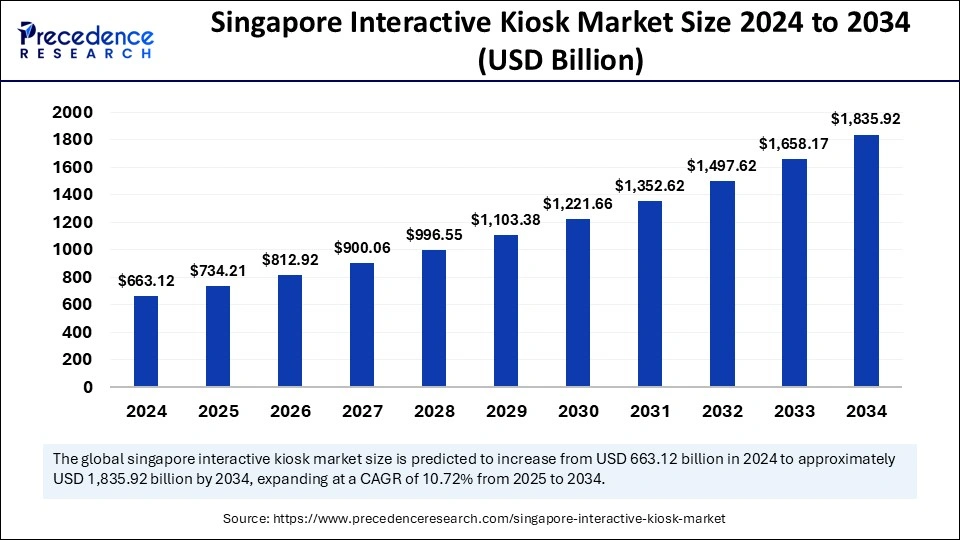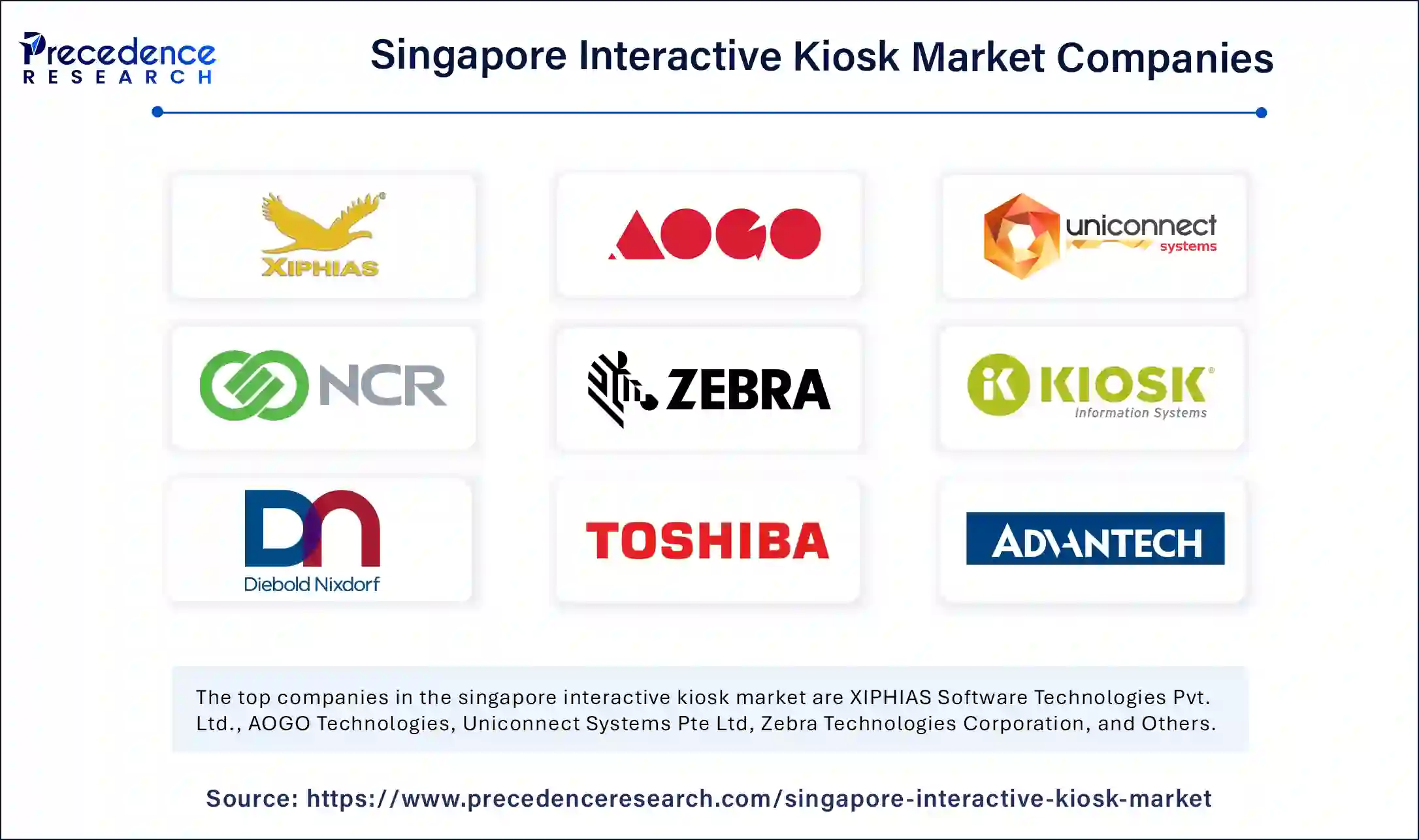November 2024
The singapore interactive kiosk market size is calculated at USD 734.21 billion in 2025 and is forecasted to reach around USD 1,835.92 billion by 2034, accelerating at a CAGR of 10.72% from 2025 to 2034. The market sizing and forecasts are revenue-based (USD Million/Billion), with 2024 as the base year.
The singapore interactive kiosk market size was estimated at USD 663.12 billion in 2024 and is predicted to increase from USD 734.21 billion in 2025 to approximately USD 1,835.92 billion by 2034, expanding at a CAGR of 10.72% from 2025 to 2034. The rising technological collaborations, increased demand for self-service technologies and growing adoption of digital technologies is fostering the growth of the Singapore interactive kiosk market.

Integration of Artificial Intelligence in interactive kiosks is leading to increased customer engagement due to enhanced customer engagement and improved user experience. AI-powered interactive kiosks are loaded with various features such as voice commands for interacting with users, utilization of natural language processing (NLP) for understanding and responding to user queries in a natural and conversational manner, optimization of processes for faster transactions, improving accessibility with multi-lingual interfaces, anticipating customer needs with real-time data processing and personalizing experiences by analyzing user data.
Furthermore, businesses in Singapore are actively adopting AI-based interactive kiosks for analysing customer behaviour and purchase patterns, for gaining in-depth insights from multiple channels and using predictive analytics for predicting trends and anticipating customer demands for optimizing inventory, promotions and store layouts.
An interactive kiosk refers to a self-service device or a computer terminal that features specialized hardware and software, often with a touchscreen allowing users access to information, completion of tasks or interacting with a system without the need for direct human assistance. They help in enhancing the efficacy and expansion of businesses with their user-friendly interfaces which further can be applied for improving customer experience and satisfaction with self-service options, personalized interactions and their 24/7 availability, ultimately boosting sales and revenue.
The ability of interactive kiosks for handling tasks quickly with reduced wait times and workload for staff, in independent completion of tasks improving customer experience, enhanced data collection for understanding user preferences and behaviour as well as the lower operational costs with reduced dependability on human staff are the factors driving their market adoption in Singapore.
Furthermore, the rising prevalence of self-service technology (SST), increased demand for digital branding services, government initiatives, shortage of labour, availability of multi-functional interactive kiosks and ongoing technological advancements and research such as implementing augmented reality (AR) and virtual reality for creating immersive user experiences are boosting the growth of the Singapore interactive kiosks market.
| Report Coverage | Details |
| Market Size by 2034 | USD 1,835.92 Billion |
| Market Size in 2025 | USD 734.21 Billion |
| Market Size in 2024 | USD 663.12 Billion |
| Market Growth Rate from 2025 to 2034 | CAGR of 10.72% |
| Base Year | 2024 |
| Forecast Period | 2025 to 2034 |
| Segments Covered | Component, Type, End Use. |
Burgeoning demand for self-service solutions
Adoption of digital technologies in various businesses in Singapore is driving the demand for self-service solutions such as interactive kiosks. Factors such as enhanced customer experience, streamlined processes, reduced waiting times, convenience of information access and increased efficiency of completing transactions is boosting the market growth.
Additionally, the ongoing advancements in touchscreen technology, readily available options of customizing orders for customers leading to increased sales rates and cost savings for businesses offered by interactive kiosks is driving their adoption in Singapore by several businesses.
High costs and technological barriers
The implementation of sophisticated kiosk systems usually requires high initial investments in software, hardware, integration services, as well as additional costs associated with developing customized software and design of kiosk based on customer needs are majorly restraining the Singapore interactive kiosk market.
Interactive kiosks need to be updated regularly and maintained for ensuring smooth operations of kiosk to prevent problems such as software and hardware issues, network congestion leading to server outages. Furthermore, disadvantages related to system compatibility, user satisfaction and complexities in maintenance with the integration of advanced technologies in interactive kiosks deters the market growth.
Diversified applications across various sectors
Ongoing technological advancements such as biometric authentication for enhancing security, integration with Internet of Things (IoT) devices for real-time data collection and development of touchless interfaces with voice activation and gesture recognition for maintaining hygiene in public places while using interactive kiosks is enabling applications in various fields.
Interactive kiosks are being implemented in industry verticals such as in retail for placing orders and making payments, in transportation for booking tickets and information services at airports and trains stations, in healthcare facilities for improving patient flow by facilitating registration process, in hospitality for enhancing guest experience with concierge services and room selection, large corporate offices for wayfinding and visitor management and also for government applications like citizen services and document filing further creating opportunities for market growth.
The hardware segment dominated the market with the largest share in 2024. The growing demand for self-service options by customers offering convenience and speed, development of innovative technologies with glass technology and touchscreen interfaces, advancements in encryption and transaction technologies, streamlined processes with enhancing service efficiency and rising applications across various industries is driving the demand for hardware components such as displays, printers, integrated circuits among other ultimately boosting the market growth of this segment.
The software segment is anticipated to witness lucrative growth during the forecast period. The market growth of this segment can be attributed to the presence of tech-savvy population of Singapore demanding cloud-based solutions such as Software-as-a-Service (SaaS) in various industries, rising investments and government initiatives for digital transformation, increased emphasis on innovation and entrepreneurship.
The automated teller machines (ATMs) segment held the largest market share in 2024. The market dominance of this segment can be linked to initiatives by various banks for increasing the availability of cash withdrawal points at several locations, growing use of ATMs by people preferring cash transactions, flourishing tourism industry and the role of the Monetary Authority of Singapore (MAS) promoting the importance and access to cash withdrawal touchpoints. As of 2023, there were about 2,484 ATMs spread across Singapore.
The retail self-checkout kiosks segment is predicted to grow at the fastest rate over the forecast period. Customer preference towards self-service options, adoption of digital technologies by businesses, increased installations of self-service kiosks in retail settings, demand for contactless services, reduced staffing costs and customization of kiosks to specific business needs are the factors promoting the market expansion.
The BFSI segment accounted for the largest market share in 2024. Banking, Financial Services, and Insurance segment market growth is driven by the availability of convenient ways for performing banking tasks with interactive kiosks, reduced operational and service costs for banking and financial institutions, advancements in secure payment and cybersecurity technologies, increased focus on customer engagement and enhanced service efficiency.
The food & beverage segment is expected to grow at the fastest rate over the forecast period. The ongoing advancements in developing interactive kiosks for enhancing customer experience with improved operational efficiency in managing high customer traffic, automating routine tasks and reducing labor costs as well as rising research activities for developing customer-friendly and autonomous kiosks, are increasing their adoption in the food and beverage sector. Interactive kiosks are implemented for specific applications such as order placement, wayfinding and processing payments. Moreover, increased research activities by companies

By Component
By Type
By End Use
For inquiries regarding discounts, bulk purchases, or customization requests, please contact us at sales@precedenceresearch.com
No cookie-cutter, only authentic analysis – take the 1st step to become a Precedence Research client
November 2024